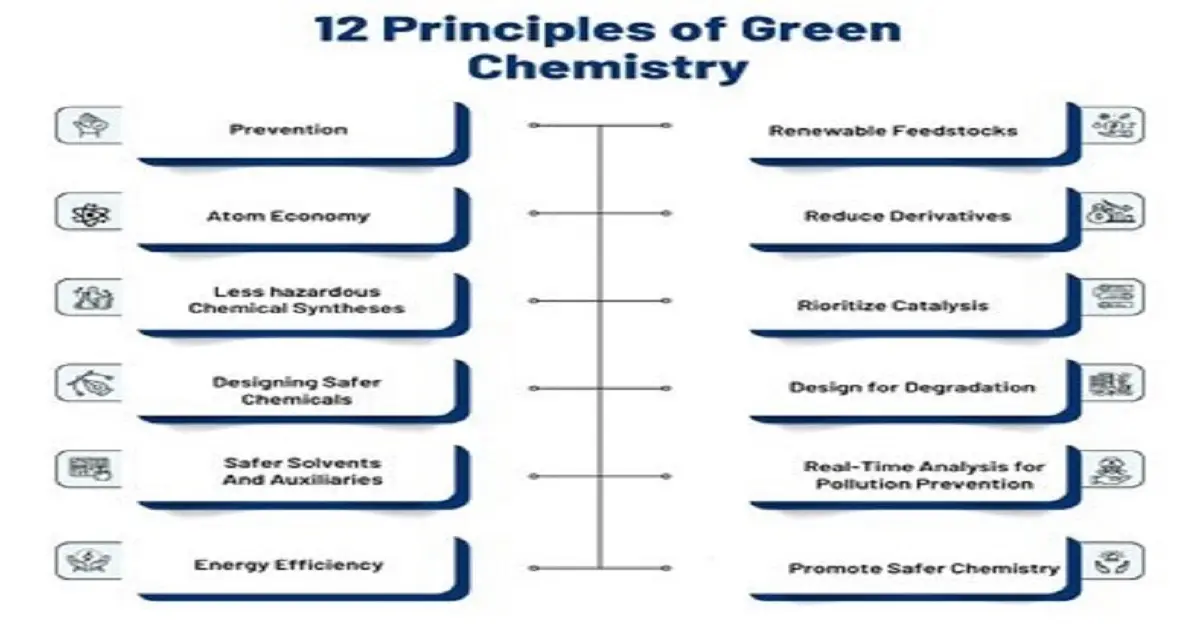Published Date : 17 September 2025
Posted by : Abhishek Bhardwaj
Imagine a world where chemicals are produced without leaving hazardous residue, where industrial processes are safe for the surrounding environment, and where innovation supports, and not harms, the planet. This is the vision of green chemistry, a revolutionary strategy to chemical research and engineering targeted at designing products and processes that decrease or eliminate the use and production of hazardous substances. As the global community grapples with climate change, pollution, and the depletion of natural resources, the importance of green chemistry cannot be overstated. It bridges the gap between science and sustainability, providing practical solutions that fulfill economic growth with environmental responsibility.
What is Green Chemistry?
Green Chemistry, also popularly known as sustainable chemistry, is the design of chemical products and processes that reduce or remove the generation of hazardous substances. Coined in the 1990s by the U.S. Environmental Protection Agency (EPA), the green chemistry concept promotes a proactive approach to pollution prevention. Unlike environmental chemistry, which emphasizes the impact of pollutants after they have been released, green chemistry plans to prevent pollution at the beginning molecular level before it happens. The key goals are as follows:
- Reduce toxic waste
- Improve energy efficiency
- Use renewable resources
- Develop safer chemical products
The 12 principles of green chemistry, developed by chemists Paul Anastas and John Warner form the core philosophy of green chemistry:

Why Green Chemistry Matters
Green chemistry plays a transformative role in how societies handle chemical production and consumption. Beyond being an ethical choice, it brings measurable environmental, economic, health, and regulatory benefits that align with both sustainability goals and business performance.
Environmental Perks- One of the most promising reasons to adopt green chemistry is its highly positive impact on the environment.
- Reduces pollution at its source: Traditional chemical processes often result in the release of harmful by-products into the air, water, and soil. Green chemistry focuses on preventing pollution rather than treating it after it has happened. It works on the fundamental that prevention is better than cure. For instance, using eco-friendly solvents like water or supercritical CO₂ in chemical reactions avoids toxic waste generation.
- Conserves natural resources: Many green chemistry strategies use renewable feedstocks like plant-based materials instead of petroleum-based resources. This reduces the pressure on limited natural resources and promotes a more sustainable materials economy.
- Eliminates climate change through low greenhouse gas emissions: Energy-efficient processes, such as low-temperature catalytic reactions, consume less fossil fuel and emit fewer greenhouse gases. Discoveries such as bio-based polymers and carbon-capture chemical processes, also help to fight climate change.
Economic Strength- Opting for green is not just good for the planet; it’s also a smart business strategy to expand. Companies that adopt green chemistry practices often have a competitive edge and long-term cost savings.
- Decreases costs associated with waste disposal, energy use, and hazardous material handling: Managing toxic waste can be costly. Thus, green chemistry reduces and eliminates waste generation at the source, thereby reducing operational and disposal costs. For instance, solvent-free reactions not only decrease waste but also lessen the need for costly protective equipment and containment systems.
- Creates new market opportunities for eco-friendly products: As consumer demand increases for biodegradable, non-toxic, and ethically produced goods, companies that offer green alternatives can jump into new and lucrative markets. The increase of natural, cruelty-free cosmetics, eco-friendly packaging, and clean-labeling of pharmaceutical products highlights this shift.
- Innovation in sustainable industries: Green chemistry brings about innovation by encouraging companies to rethink product design. This has led to the establishment of green startups and new technologies in renewable energy, biotechnology, and materials science sectors. Companies such as DuPont, BASF, and Covestro are therefore investing in environment-friendly R&D to enhance their product portfolios.
Health and Safety- Chemicals are key to modern life, but many chemicals pose serious health concerns. Here, green chemistry prioritizes the design of substances that are safer for humans and ecosystems.
- Less exposure to toxic substances for workers and consumers: By replacing carcinogenic or neurotoxic chemicals with safer alternatives, green chemistry protects workers in manufacturing environments and lowers consumer health risks. For example, replacing formaldehyde-based resins in construction materials with bio-based adhesives improves indoor air quality.
- Reduces accidents and harmful incidents in the chemical sector: Traditional industrial chemistry generally involves flammable, explosive, or highly reactive compounds. Green chemistry promotes the use of stable and less hazardous materials, lowering the risk of industrial accidents, spills, and fires. Moreover, it promotes safer reaction conditions, such as suitable temperature and pressure, reducing operational dangers.
Regulatory and Compliance- As environmental concerns grow, governments worldwide are tightening regulations on chemical usage and emissions. Green chemistry offers a proactive path to compliance. It helps industries comply with stricter environmental laws such as REACH (EU), EPA (USA), and other global standards. As regulatory bodies now enforce safer chemical handling and transparency about environmental impact, green chemistry aligns naturally with frameworks like:
- REACH (Registration, Evaluation, Authorization and Restriction of Chemicals) in the European Union requires companies to identify and manage risks linked to the substances they manufacture and market.
- EPA’s Safer Choice Program in the US marks products that perform well and are safer for human health and the environment.
- India’s Chemical Management and Safety Rules (CMSR) and China’s New Chemical Substance Notification (NCSN) also reflect global efforts toward greener policies. Companies that incorporate green chemistry principles are in a better position to comply to regulatory changes, avoid heavy fines, and maintain global market entry.
Emerging Technological Developments in Green Chemistry
Green chemistry, along with cutting-edge science and technology, includes notable developments as follows:
- Artificial Intelligence in Molecular Design: AI helps design molecules that are both effective and environmentally benign.
- Biocatalysis: Enzymes used as green catalysts improve reaction efficiency and specificity.
- Solvent-Free Reactions: Mechanochemistry allows chemical reactions irrespective of any harmful solvents.
- Green Nanotechnology: Nanoscale materials are made using safer processes for use in medicines, electronics, and other applications.
- Electrosynthesis: Electricity, often extracted from renewable sources of energy, is used to power chemical reactions instead of reagents.
The future of green chemistry is overly exciting and expansive. As the demand for sustainable solutions grows, green chemistry is likely to integrate with circular economy models and ensure resource recovery and reuse. Empower green entrepreneurship in areas like biomaterials, food tech, and zero-waste products. It can moreover promote global UN’s Sustainable Development Goals, and empower multidisciplinary partnerships between chemists, engineers, data scientists, and environmentalists. With rapid advancements in digital technology, policy support, and public awareness, green chemistry is likely to become the norm rather than an exception in the coming decades. Green chemistry is more than just a scientific discipline; it's a shift toward a cleaner, safer, and highly sustainable world. By reimagining how we design, manufacture, and use chemicals, we can reduce our environmental footprint, protect human health, and drive innovation.
Contact Us







